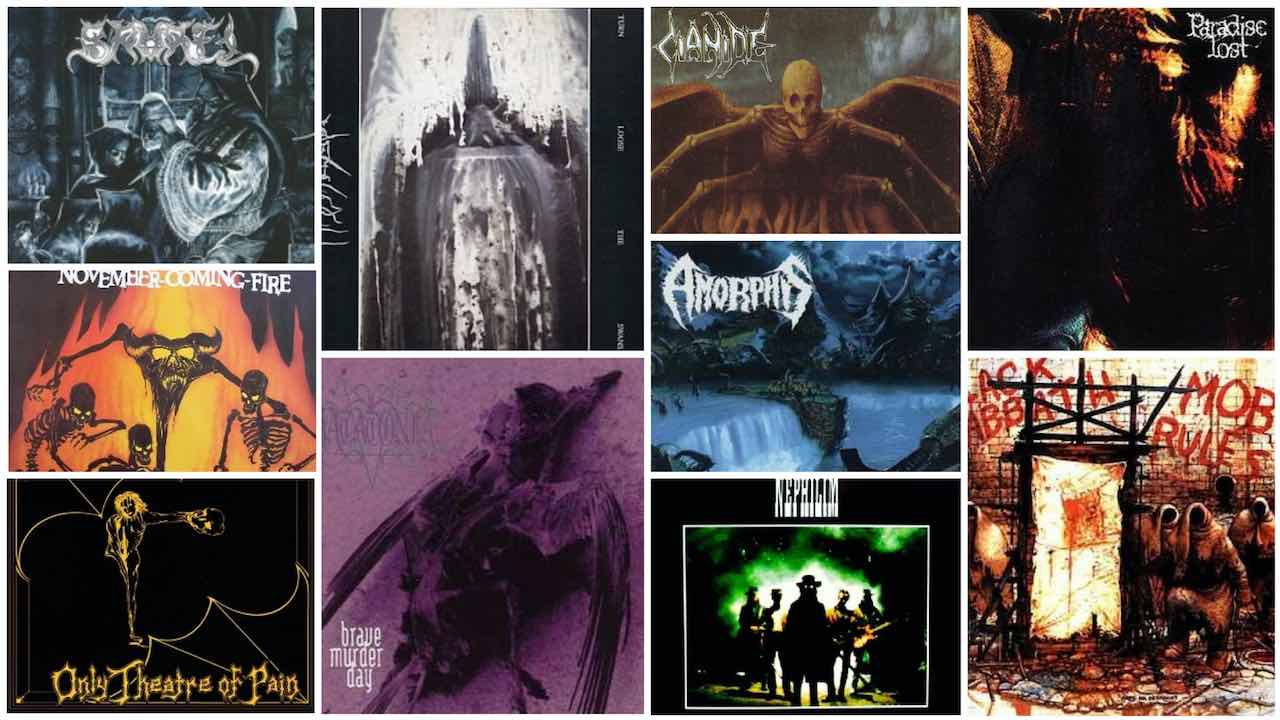What is “death-doom”?
Genres are handy when you own a record store and are looking for a way to categorize records for your patrons. To us in Pulchra Morte – that’s Adam Clemans, John Porada, Jarrett Pritchard, Jeffrey Breden and Clayton Gore – death-doom defines an era where bands that played heavier music resisted the urge to play faster and more technically, and embraced the idea of a complete song over a collection of riffs.
While music is subjective and, by design, something that’s difficult to clearly define, death-doom is something that favours songs that elicit feeling, that scratch the scab of hurt and wallow the melancholy, drawing on emotions beyond pure aggression and anger, channelling something deeper for the listener to embrace.
When the opportunity to draw up a list of the best death-doom albums presented itself, our initial internal discussion as a band resulted in 27 albums. There were some heavy casualties whittling this list down to ten, and we’re positive some will highlight what are some glaring omissions in their mind. That’s the beauty of art - it is subjective, there is no one truth. We can only hope that you at least give the albums in our list a listen and decide for yourself where they belong in the hallowed pantheon of death doom.
Pulchra Morte’s new album Ex Rosa Ceremonia is out now

My Dying Bride – Turn Loose The Swans (1993)
My Dying Bride was one of the initial first wave of modern death-doom metal, taking the characteristics of death metal and drawing out the expression, underscoring the sadness inherent in the music. Having set the stage with the incomparable Symphonaire Infernus Et Spera Empyrium EP this feels like the album where everything coalesced into form.
Black Sabbath – Mob Rules (1981)
What can you say about Black Sabbath that hasn’t been said? Godfathers of modern metal, they’re responsible for beginning what a great majority of most readers of Metal Hammer listen to today, and this album feels like it has the most “doomy” overall atmosphere to it. Just listen to Sign Of The Southern Cross and Over And Over.
Katatonia – Brave Murder Day (1996)
Katatonia brought melody and groove to their brand of metal. A fantastic vocal performance highlights what they were doing here, and elaborated on what Mikael Akerfeldt began with Opeth. Filled with hooks and earworms, this is an album that begs to be heard.
Amorphis – Tales From The Thousand Lakes (1994)
While Amorphis have enjoyed a long and storied journey, something about the experimental nature of this album fits quite well into the box drawn by the idea of death-doom. A death metal band willing to put a Moog solo on a record is clearly deep in the doom well.
Samael – Blood Ritual (1992)
Samael is a band that has never feared experimentation. Some may say their early work is more properly defined as black metal, but we’d say that the line between real black metal and so-called death doom is very blurry. Heavy, tight, well-crafted songs highlight the deliberate fury of this record.
Fields Of The Nephilim - Dawn Razor (1987)
At least a segment of death doom contains more goth-oriented artists that were drawn to the heavier aspects of metal and found a way to incorporate the two ideas. The endpoints of that spectrum are not as far apart as may seem on initial inspection, and the genre owes a lot to the movement of which Fields Of The Nephilim are a waypoint. For proof, take a look at how easily Carl McCoy transitioned to metal a few years later with The Nephilim’s Zoon.
Samhain – November Coming Fire
While death rock idols The Misfits preceded Samhain, the latter explored a darker, more deliberate side of the subject matter. Most death-doom bands owe quite a bit, consciously or unconsciously, to Samhain, and this album is, to us, where everything came together.
Christian Death – Only Theater Of Pain (1982)
Stepping further back, Christian Death was a very early flag bearer for the darker side of emotion, and the instincts displayed here informed everything that followed. It was a stepping stone where melody was used to give voice to darkness.
Cianide - The Dying Truth (1992)
On the heavier end of the spectrum of death-doom, this slab of oppression is pure aggression on the surface, but upon further inspection reveals a darker soul and a deceptive depth of songwriting. While not necessarily pioneering a movement, something about this record speaks to the soul.
Paradise Lost – Gothic (1991)
While Paradise Lost came out of the gates with a powerful, relentless slab of metal on their debut album, Lost Paradise, this follow-up found them embracing more hooks, structure, and other sounds like keys and female vocals. The result is nothing short of astounding, and a landmark in the genre we so love.
